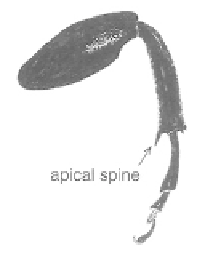Agriculture Reference
In-Depth Information
particularly severe if seedling growth and, hence,
crop establishment is retarded; in some cases
whole crops may be lost. New adults, reared in
the summer, attack the leaves and developing
seed capsules of older plants; heavy infestations
lead to stunting and distortion but are of lesser
significance than spring attacks. Minor damage is
also caused to the foliage of various other plants,
including apple, beet, cereals and strawberry.
Fig. 211
Hindleg of bean beetle,
Bruchus rufimanus.
BIOLOGY
Adults hibernate in herbage in hedgerows and
woodlands, and usually emerge in April but typi-
cally slightly later in the season than the flax flea
beetle,
Longitarsus parvulus
(p. 144). They then
feed on the leaves of various plants, and often
cause damage to the seedlings of flax and linseed.
After mating, eggs are laid in the soil at a depth
of 5-10mm, close to the roots of host plants.
The eggs hatch in approximately 2-3 weeks.
The larvae then burrow into the roots of flax,
linseed and weeds such as
Euphorbia, Plantago,
Sisymbrium officinale
and
Taraxacum officinale,
where they feed for about 4 weeks. When fully
grown, they escape back into the soil where they
pupate, and new adults emerge approximately 9
days later. These new adults feed from mid-July
to August and then seek overwintering sites.
There is just one generation annually.
tarsi reddish;
hind tibiae
with a distinctive apical
spine
(Fig. 211). Egg
0.5 x 0.25mm, oval and
flattened, yellowish-green.
Larva
up to 6 mm
long;
body
creamish-white;
head
brown, with
powerful mandibles;
thoracic legs
present but
minute.
Bruchus pisorum
(L.)
Pea beetle
This pest is associated only with pea crops.
the larvae feeding within the developing seed.
Although virtually cosmopolitan in distribution
and often common in continental Europe, in-
festations in the British Isles occur only on
imported infested seed. The adults (4.0-4.5 mm
long) are similar in appearance to those of
Bruchus rufimanus
(p. 137) but distinguished by
the black anterior femora and by the absence of
a spine on the hind tibia.
DESCRIPTION
Adult
1.5-2.0mm long, black with a blue or
greenish metallic sheen;
prothorax and elytra
finely punctured;
antennae
yellowish-red, the
apical five segments dusky;
legs
mainly
yellowish-red (cf. flax flea beetle,
Longitarsus
parvulus,
p. 144).
Family CHRYSOMELIDAE
(leaf beetles)
Aphthona euphorbiae
(Schrank)
Large flax flea beetle
Cassida nobilis
L.
Beet tortoise beetle
Infestations of this widely distributed flea beetle
are associated mainly with flax and linseed. Small
pits or notches are made in the cotyledons,
hypocotyls, leaves and stems; the beetles can also
feed on the germinating seeds before the coty-
ledons have emerged from the soil. Most damage
occurs in April and early May, and attacks are
This beetle is a sporadic and usually minor pest
of mangold and sugar beet. Various other mem-
bers of the Chenopodiaceae are also attacked.
Adults and larvae bite holes into the underside
of the cotyledons and leaves of host plants,
often leaving the upper epidermis intact; initial

